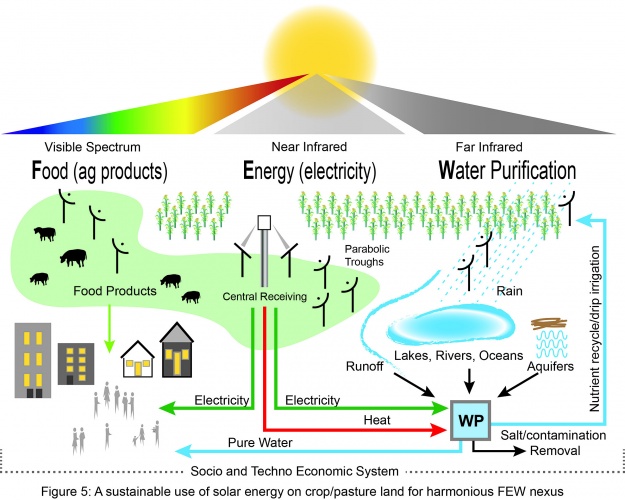
(Credit: Purdue University)
Described in the journal Scientific Reports, the concept involves splitting solar rays into the three segments best suited to the production of food, energy and water (FEW), all in one location. Current photovoltaics generally prevent the land they inhabit being used for agriculture. The proposed system would use parabolic troughs that transmit the photons necessary for plant growth, while reflecting the other parts of the spectrum to specially designed solar cells that would generate electricity and power water purification.
“This increase in population, coupled with rising per capita income and associated change in consumption habits, will put unprecedented stress on food, energy and water resources,” said Rakesh Agrawal, a professor at Purdue’s School of Chemical Engineering. “The grand challenge before us is to sustainably meet the needs of a full earth using scarcer resources, and the sun is the key energy source to achieve this goal.”
“With the three-way split, the entire spectrum is judiciously used for the production of food, energy and water resources.”
While the idea of splitting solar rays to maximise electricity and heat output is well established, the concept has never been explored in a system that incorporates FEW resources on the same land. According to the Purdue team, this holistic approach could help create self-sufficient communities and networks that are more resilient.
“A major feature is the ability to produce food, energy and water resources locally without interfering with agricultural production, which will be increasingly important, as expected population growth will require increased dedication of land resources to agriculture,” Agrawal said.
“At the same time, the local generation of electricity will allow the use of microgrids in villages and provide a new paradigm for electricity generation and distribution.”
Water from various sources would enter purification units powered by the heat and electricity generated from sunlight. The purified water would then be used for irrigation or household needs, with any salts and waste sent for further processing, recycling or disposal.





Red Bull makes hydrogen fuel cell play with AVL
Surely EVs are the best solution for motor sports and for weight / performance dispense with the battery altogether by introducing paired conductors...